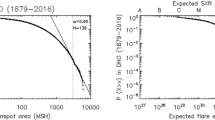Abstract
Using eighteen years of observations at Big Bear, we summarize the development of δ spots and the great flares they produce. We find δ groups to develop in three ways: eruption of a single complex active region formed below the surface, eruption of large satellite spots near (particularly in front of) a large older spot, or collision of spots of opposite polarity from different dipoles. Our sample of twenty-one δ spots shows that once they lock together, they never separate, although rarely an umbra is ejected. The δ spots are already disposed to their final form when they emerge. The driving force for the shear is spot motion, either flux emergence or the forward motion of p spots in an inverted magnetic configuration.
We observe the following phenomena preceding great flares:
-
1.
δ spots, preferentially Types 1 and 2.
-
2.
Umbrae obscured by Hα emission.
-
3.
Bright Hα emission marking flux emergence and reconnection.
-
4.
Greatly sheared magnetic configurations, marked by penumbral and Hα fibrils parallel to the inversion line.
We assert that with adequate spatial resolution one may predict the occurrence of great flares with these indicators.
Similar content being viewed by others
References
Donnelly, R. F., ed.: 1975, Solar-Terrestrial Predictions Proceedings Vol. 3, Cl. NOAA-ERL.
Kunzel, H.: 1960, Astron. Nachr. 285, 271.
Kunzel, H., Mattig, W., and Schroter, E. H.: 1961, Die Sterne 9/10, 198.
Patterson, A. and Zirin, H.: 1981, Astrophys. J. 243, L99.
Rust, D. M.: 1968, IAU Symp. 35, 7.
Sawyer, C. S., Warwick, J. W., and Dennett, J. T.: 1986, Solar Flare Prediction, Colorado.
Smith, S. F. and Howard, R. F.: 1968, IAU Symp. 35, 33.
Tanaka, K.: 1975, BBSO Preprint No. 0152.
Tanaka, K.: 1980, in R. F. Donelly (ed.), Solar-Terrestrial Predictions Proceedings Vol. 3, Cl. NOAA-ERL.
Tanaka, K. and Zirin, H.: 1985, Astrophys. J. 299, 1036.
Tang, F.: 1983, Solar Phys. 89, 43.
Zirin, H.: 1970a, Solar Phys. 14, 328.
Zirin, H.: 1970b, Solar Phys. 14, 342.
Zirin, H.: 1983, Astrophys. J. 274, 900.
Zirin, H. and Tanaka, K.: 1973, Solar Phys. 32, 173.
Zirin, H. and Tanaka, K.: 1981, Astrophys. J. 250, 791.
Zirin, H. et al.: 1982, Astrophys. J. 259, 392.
Author information
Authors and Affiliations
Rights and permissions
About this article
Cite this article
Zirin, H., Liggett, M.A. Delta spots and great flares. Sol Phys 113, 267–283 (1987). https://doi.org/10.1007/BF00147707
Published:
Issue Date:
DOI: https://doi.org/10.1007/BF00147707




